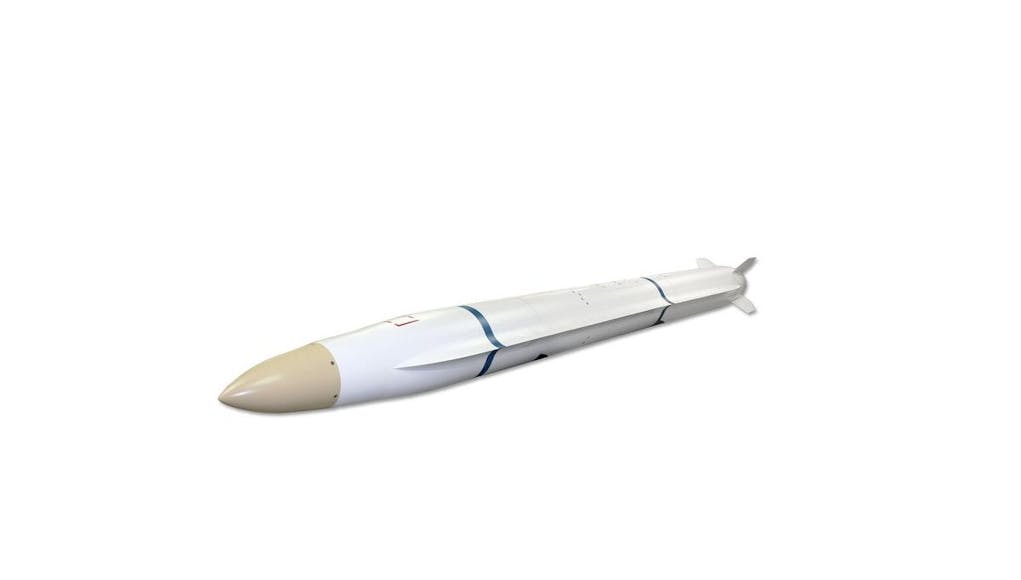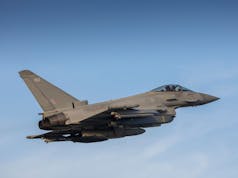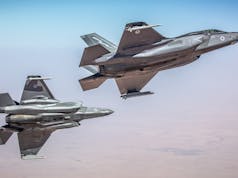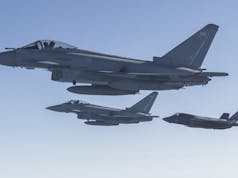Northrop Grumman has received a $322.5 million contract from the US Navy for the Advanced Anti-Radiation Guided Missile-Extended Range (AARGM-ER) Engineering and Manufacturing Development (EMD) programme.
The AARGM-ER will be integrated on the F/A-18E/F Super Hornet and EA-18G Growler aircraft and configured for internal carriage on the F-35.
“AARGM-ER extended range coupled with AARGM lethality will meet a critical defense suppression requirement while protecting our strike aviators,” said Cary Ralston, vice president, defense electronic systems, Northrop Grumman.
AARGM is currently deployed with the US Navy and US Marine Corps on the F/A-18C/D Hornet, F/A-18E/F Super Hornet and EA-18G Growler aircraft.
AARGM is also integrated on the Italian Air Force’s Tornado aircraft.














Will these fit in the F35b?
This is a capability that i really don’t understand why we don’t have. What is the point of having such expensive fighter/bombers or transport aircraft if we can’t break through the air defense. I am sure the counter argument is that tomahawk is there for that job, but its been proven in Libya that we don’t have enough of them.
i’d have expected that, given the time and effort going into technology such as dragonfire, that the u.k wouldn’t be at the forefront of such technology price per unit will be interesting assuming that they actually work
We specifically designed SPEAR 3 for this capability and it fits inside the internal bays of F35B, beam riding missile are and old technology. The US equivalent is SDB II which is unpowered and lacks sufficient range to get an F35 close enough to certain radars to take them out.
F35 does not need a beam riding weapon, it’s abke to locate and image an air defence system then use a guided weapon like SPEAR to take it out. The smaller weapon allows the F35 to carry more as well.
https://m.youtube.com/watch?v=-ub9IL9fflU
Hers a video of how the RAF will now be taking out surface to air threats.
Also I seriously doubt we will see AARGM ER on F35 before 2030, it’s not on block IV program to my knowledge.
The AARGM is also currently in the RAAF’s inventory for ita FA18G Growlers. In 2017 the RAAF acquired an initial tranche of 70 AGM-88B HARM and 40 AGM-88E AARGM through a Foreign Military Sale (FMS).
The AARGM-ER is also certain to be acquired by the RAAF given their stated commitment to keep the Growler airframe, jammers and weapons systems in lock step with the USN aircraft.
The fact that it can be carried internally by the RAAFs 72 F35As makes it a no-brainer, although the Pentagon’s FY2019 Budget Request shows the AARGM-ER is not expected to reach IOC till 2023.
Over the past 10 years or so the RAAF has built a very impressive and highly capable AF. I’m very impressed with their gear and their people. Definitely a tier 1 fighting force to say the least.
Too bad Germany doesn’t follow their lead….
AARGM’s seeker already includes three separate modules working together: passive radar, millimetre radar and INS/GPS, making it possible to neutralize moving targets or objects that do not emit radar signals. So it no longer relies on riding a beam in the way older HARM missiles did.
The AARGM already outranges SPEAR (150km vs 130km) and while the target range hasn’t been made public the extended range (ER) version will obviously have a longer range again.
More tellingly AARGM is a Mach 2 missile compared to SPEAR closing on a target at subsonic speed so far less time for an adversary to react or deploy countermeasures.
If you have a weapon like SPEAR 3 then this seems like a very niche capability, SPEAR can hit more targets more accurately as it also has optical guidance. The speed and range of this weapon come with benefits but an F35A can only Cary 2 of these instead of 8 of SPEAR, this weapon is handy for an F35 to take out longer range Low frequency radars but then this are probably better tackled by a much longer range weapon like JASSM ER or stomshadow/ SPEAR 4
I can see the new for an Air Force using legacy 4th generation aircraft for SEAD like RAAF or USN but for an all stealth force like RAF, USMC and USAF there seems like little benefit which is probably why none of those are buying it.
I can see a need for a much larger weapon than SPEAR 3 for internal carriage on F35B but it needs to be more multi purpose than this and should be able to target ships and buried targets.
Am I right in saying these will only take out the radar sets and not the launchers?
You’re missing the point about how the Growler operates. It’s not some legacy leftover platform that is all that second tier air arms have to hang anti radiation missiles off.
It is a (relatively) new and purpose built EW/EA platform which already has the most sophisticated jamming equipment of any fast jet in the West’s inventory.
It’s next generation jammers, which the RAAF is cofunding with the USN, will be even more capable again including being able to conduct cyber attack’s against enemy radar’s software.
The Growler offers multi-frequency jamming on both ingress and egress to targets, a capability the F35, despite its sensor fusion is unlikely to match.
The combination of the RAAF’s F35As and Growlers will be a potent SEAD/DEAD duo.
Keep in mind the USN will also have stealth F35Cs operating alongside their Growlers and the USAF will soon need a replacement for the AARGM’s it currently employs on its Wild Weasal F16s.
The RAF an all stealth force?? A 4.5 Gen Super Hornet is arguably more stealthy than any Typhoon variant.
The RAAF will have a ratio of 2:1 stealth to 4.5 Gen platforms (72 F35As and 36 Super Hornets). The maths for the RAF will depend on how many Typhoons you retain in service when Tranche 1s are retired and how many F35Bs the RAF actually can count in their inventory given the FAA and QEs are likely to be the priority for their deployment. .
Just for the record the ‘all stealth’ USMC and USAF currently look like this:
USMC: 178 FA18; 80 AV8B Harrier: 60 F35B
UASF: 178 F22; 266 F15C; 165 F15B; 791 F16C; 120 F35A
No F15Es?
In 2017 the RAAF signed an FMS deal for 3,900 GBU-53/B Small Diameter Bomb Increment II (SDB II) with a range of 110 km just shy of SPEAR 3.
The RAAF inventory also has the JSOW-C JSOW Block III, which adds a Link-16 weapon data link and moving maritime target capability and is co-funding the development of a new seeker for maritime strike for Kongsberg’s Joint Strike Missile plus JDAMs with Australian developed glide wing kits or in extremis JASSM cruise missiles.
No shortage of stand-off RAAF options for SEAD/DEAD.
SDB is a glide bomb which means the launching aircraft will have to be above the radar horizon to get the “range” you list. SPEAR 3 is turbojet powered missile with >140km range. It can be launched below the radar horizon and still get its range, which is a far more attractive option if flying a 4 or 4.5 Gen aircraft.
Every time I see something about anti-radiation missiles my addled brain thinks ‘we’ve found something to neutralise fallout?’
You looking at the forces today rather than the forces of five or ten years from now which is the earliest this missile might ever appear on F35. Current plans are still for 138 F35 in RAF with probably 100 or so upgraded Typhoons and the Typhoons will not be doing the SEAD work except lobbing stormshadow from very far away.
While the F18 G has some impressive electronics and the NJG will certainly be an amazing capability the F18 E/F itself is a legacy platform and not even a particularly good one compared to other 4.5 gen aircraft like Rafael or Typhoon.
It’s worth noting that neither the USAF or the USMC have any plans for any kind of jamming fighter capability much less a wild weasel. F35 will do it all. While the USN has a F35C it is only schedule to replace a small part of its inventory.
Their is a lot more to F35 than sensor fusion, it’s also comes with full electronic Attack capability in built. NJG was earmarked for F35 integration by the current assessment by Lockheed, the USAF and the USMC is that it’s not needed.
The USMC is planning to go all F35 and the USAF May end up with the majority of of its fleet being F35, especially when there are already plans to scrap F22 early and there is no slated replacement for F15E
How far into the future do you want to crystal ball?
In that case the RAAF has flagged from the inception of its involvement in the F35 program the option to acquire a further 24 F35A to replace the current 24 FA18F’s leaving only the 12 Growlers in service so the ratio of stealth to legacy platforms would be even higher around 88%.
Add to that the Boeing’s recently announced stealthy ‘loyal wingman’ platform and, depending on the numbers acquired, that ratio of stealth to legacy platforms pushes above 90%.
I’m not sure what the argument is here though. If the F35 can be relied on to perform all future SEAD/DEAD tasks then the RAAF’s F35As with a larger weapons bay give it even more options then the F35B. While in terms of current capabilities the FA18G’s already provide a potent capability.
The AARGM replaced the legacy HARM that relied on beam riding to the target radar, that also contained memory to record the target’s location if the radar was operating intermittently. We replaced HARM with the much more capable ALARM, this had a much higher off the rail speed but also had the ability to loiter by using a parachute. It did very well in Gulf War 2 as it had a much broader bandwidth, so could be used against radio masts (2/3G) besides radar. The problem the RAF had was that it was told to focus on contingency ops i.e. combating non-peer groups and reducing collateral damage. This led to the Brimestone development from a “simple” anti-tank weapon to a multi-use weapon. So all the funding went to this rather than further developing ALARM. In theory the Brimstone could have a secondary anti-radar function as it uses a millimetric acquisition radar, that could be used in a passive mode, though it wouldn’t work so well with tracking long wavelength radar due to the size of its antenna array. The best option we have is AMRAAM/Meteor as they have a secondary passive radar function, with Mach 4+ performance. Again they would struggle tracking long wavelength radar. Spear 3/4 does not have a passive radar function, so will have to rely on the parent aircraft for targeting information.
If the ALARM was as good as some people claim it was I’m sure the Brits would have found some way to keep it in their inventory especially with nothing in the pipeline to replace it. This leaves the Brits totally dependent on others like the US, Aussies, ect to handle SEAD operations for them. Or maybe they think the F-35 can handle this mission? Would be nice if they would purchase a squadron of Growlers…..